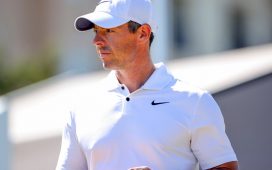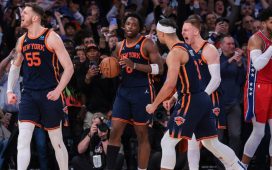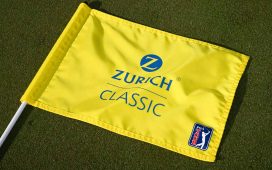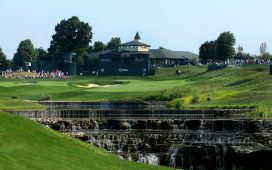Prior to Sunday’s The Match: Champions for Charity, fans had watched competitive golf just once from Medalist Golf Club.
It was on March 5, 1995, two months after it opened, when world No. 1 Nick Price beat Medalist co-founder and world No. 2 Greg Norman in a “Shell’s Wonderful World of Golf” event. Norman, who was coming off a tough defeat to Nick Faldo the previous day at the Doral-Ryder Open when he bogeyed the last hole, lost to Price by four shots after a 4-over 76 on the course he co-designed with Pete Dye.
There were maybe 3,000 spectators on hand that Monday morning at the Treasure Coast course, with most of the exposure coming months later when the Shell’s episode was aired. And re-aired.
Sunday’s televised match at Medalist went to a slightly larger audience on Turner Sports: 5.8 million viewers. That made it the most-watched golf telecast in cable television history.
Larger than, gulp, the Masters. To quote Verne Lundquist, “Never in my life …”
There were two reasons for the smash ratings:
The appeal of icons Tiger Woods, Phil Mickelson and NFL quarterbacks Tom Brady and Peyton Manning, providing the event with crossover appeal.
Fans are starved to see live sports after every major league or tour has been shut down for 2½ months because of the coronavirus pandemic.
Sure, it was a little strange to see Woods and Mickelson wearing shorts, playing in front of no fans, riding alone in souped-up carts with no caddies and mic’d up.
We need to see more of that last portion.
Hearing Mickelson go through an in-depth explanation to announcer-for-the-day Justin Thomas on how he would play his chip on the second hole — taking into account the rain, the grain and the spin — was priceless.
So was Woods. After listening to Mickelson yapping about how he had drank coffee, was about to “activate” his calves and hit a “bomb” on the first long-drive hole, Tiger dryly looked at the camera and said, “Yes, ladies and gentleman, this is what I have to listen to every time I play with him.”
Just after announcer Charles Barkley derided Brady after a horrific start, telling him he would have to give the 8-handicapper shots in a match, Brady responded by holing a wedge from the seventh fairway for a birdie.
“Suck on that Chuck!” said Brady, who no doubt has said far worse during his six Super Bowl wins. Only we could never lip-read those comments because he was wearing a helmet.
If I worked for the PGA Tour, I would demand on-course access to all the players. Now.
Most of them don’t want to be interrupted during their five-hour rounds because it would interrupt their focus. Well, most of us would prefer not to be wearing a mask or going months without seeing our loved ones, but then almost 100,000 Americans have died from the coronavirus.
Things have changed in our world because of COVID-19, and professional sports needs to connect to a new normal.
On-course interviews haven’t hurt the PGA Tour Champions. It doesn’t matter what a player says, short of saying what club he hit, because there is no defense in golf.
When the PGA Tour returns in two weeks, there will be no spectators for at least the first four events and a lot less fans for the foreseeable future. Without crowd noise, let’s hear more from the players and their caddies.
Golfers can’t rely on crowd support to energize them, but didn’t they learn how to play the game in solitude? Isn’t making more than $1 million to win a golf tournament enough of a motivation?
The lack of fans will hurt pro golfers in other ways. Medalist member Brooks Koepka was the first to point out the best players will start losing balls on tour because there won’t be thousands of fans and marshals to keep an eye on them.
This, from a guy who has won four (and has a pair of second-places) of his last 10 majors.
There are other ways the game will become more difficult for the world’s best.
There won’t be thousands of spectators (or large grandstands) to stop a foul ball from running into the rough, out-of-bounds or penalty areas. Even slightly off-line shots will land in rough that hasn’t been trampled down by fans. And players won’t need to ask for a free drop if their crooked shot lands behind a pavilion.
The pros will have to – oh my gosh – play the game like the rest of us.
Wouldn’t that be special?
The best part about The Match: Champions for Charity was it raised $20 million for COVID-19 relief efforts. And, just maybe, it provided a blueprint for how professional golf can become even more entertaining.
Less quiet, please.








